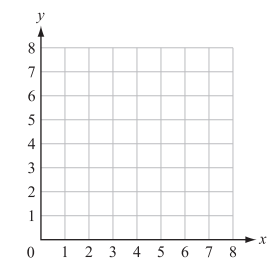All ISEE Lower Level Math Resources
Example Questions
Example Question #1 : How To Find A Triangle On A Coordinate Plane
A coordinate plane is shown.

Ralph plotted the following points on the coordinate grid:
Point X (7, 0); Point Y (7, 5); Point Z (0, 5)
A polygon is formed with vertices X, Y, and Z. Which type of polygon is formed?
Parallelogram
Rectangle
Square
Triangle
Pentagon
Triangle
Start by graphing and connecting the vertices.

The created figure has 3 sides and 3 angles. The only answer choice that has these characteristics is the triangle.
Example Question #2 : How To Find A Triangle On A Coordinate Plane
A coordinate plane is shown.

Ralph plotted the following points on the coordinate grid:
Point X (8, 8); Point Y (1, 4); Point Z (6, 5)
A polygon is formed with vertices X, Y, and Z. Which type of polygon is formed?
Triangle
Quadrilateral
Rectangle
Square
Triangle
Start by plotting and connecting the ordered pairs.

The created figure has 3 sides and 3 angles. The only answer choice that has these characteristics is the triangle.
Example Question #951 : Isee Lower Level (Grades 5 6) Mathematics Achievement
Which of the following sets of points would form a triangle if plotted on a coordinate plane?
A triangle consist of three points. The correct answer is the only set that contains three points.
Example Question #1 : Parallelograms

What is the perimeter of parallelogram ABCD?
Cannot be determined
The perimeter of a parallelogram is very easy to find. You just need to add up all the sides. However, you need to notice that the sides "across" from each other are equal on parallelograms. So, your figure could be redrawn:

The perimeter of your figure is therefore:
Example Question #1 : How To Find The Perimeter Of A Parallelogram
A parallelogram has a side length of . It also has a side length of . Calculate the perimeter.
A parallelogram has four sides and its opposite sides are equal in length. Therefore, if it has one side length of, it also has another side length of of . Since we know one of its side lenghts is , then the remaining side is . We can add all 4 side lengths to calculate the perimeter.
Example Question #21 : Geometry
What is the perimeter of a parallelogram if the base is , the other side is , and the height is ?
The perimeter of a parallelogram is the sum of all four sides or the sum of two times each side length. The side lengths are and so the perimeter is .
Example Question #1 : Plane Geometry
Find the perimeter of the given parallelogram:
Find the perimeter of the given parallelogram:
The perimeter of any shape can be found by adding up the lentghs of its sides.
In this case, we have four sides. 2 that are 16 miles long, and 2 that are 144 miles long.
Find perimeter as follows:
Making our answer 320 miles
Example Question #1 : Parallelograms
Find the area of the parallelogram:

Example Question #1 : Quadrilaterals

What is the area of the parallelogram ABCD?
A parallelogram's area is found by multiplying its height by the base. The height of the parallelogram is not the side. It is the line that makes a right angle with the base. Therefore, the area of this parallelogram is:
Example Question #1 : How To Find The Area Of A Parallelogram

What is the area of parallelogram ABCD?
A parallelogram's area is found by multiplying its height by the base. The height of the parallelogram is not the side. It is the line that makes a right angle with the base. Therefore, the area of this parallelogram is:
Certified Tutor
All ISEE Lower Level Math Resources



























































